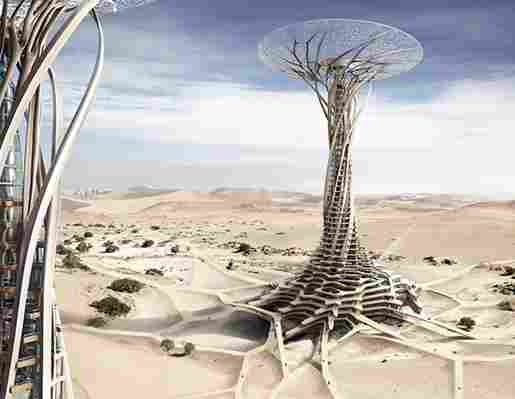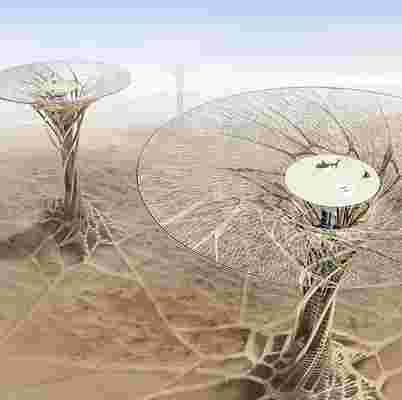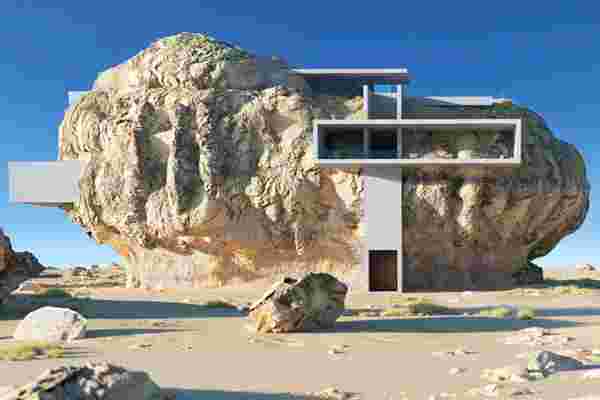
Sometimes the most beautiful architectural structures are simply fictional designs, awaiting to manifest into reality. Whenever I see such designs, I am filled with eagerness and impatience, “When and where will I get to see these breathtaking buildings? “And Amey Kandalgaonkar ‘s exquisite renderings are one such example. His surreal designs vary from a home snugly fitted into a rock, a traditional pagoda with a modern twist, to a house designed especially for Mr. Elon Musk! Inconceivable, unique, and deeply imaginative, almost all his designs seem to be at one with nature. Natural formations aren’t seen as intrusions here but as an intimate part of the home space.
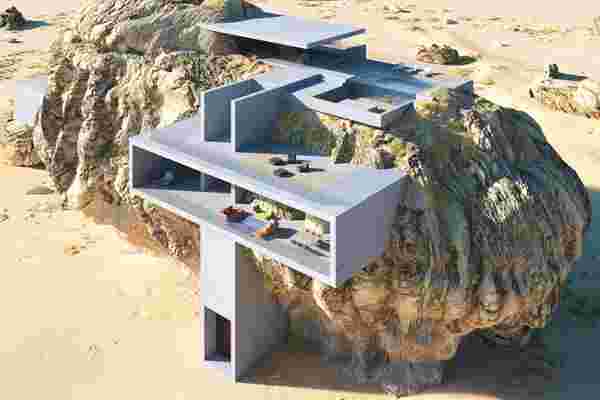
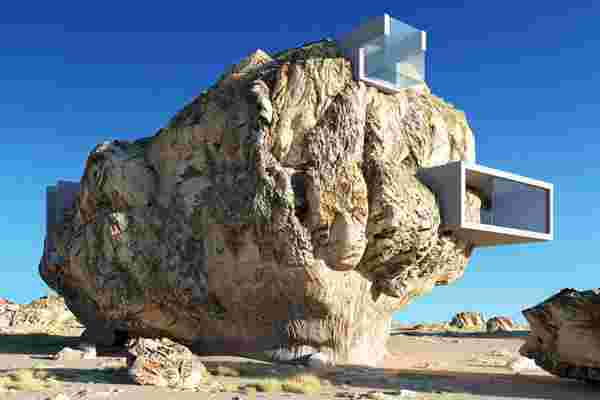
Almost surreal in appearance, the ‘House Inside a Rock’ by Amey Kandalgaonkar creates a contrast – using a natural stone shape carved from years of battling with nature and a concrete and glass interior to carve out the living space. Taking influence from the rock-cut tomb architecture of Saudi Arabia’s Madain Saleh, this ancient archaeological site is the perfect mix of the old and the new. The designer of the concept says, “When I first saw the images of rock cut-tomb architecture, I knew I had to use it as an inspiration in an architectural project. There is a huge amount of architectural heritage laid out for us by past builders and I believe they did a great job of integrating built environments in natural elements.”
Kandalgaonkar imagined his ‘Dragon House’ to be located on the edge of a cliff, with breathtaking views of a perfectly turquoise waterbody. It will remind you of a lethal, scaly dragon lounging on the ocean, basking in the sun, planning its next hunt! Although it does seem a little impractical and difficult to construct with concrete, I would certainly love for this design to see the light of day.
Inspired by his travels through China, Kandalgaonkar created a traditional pagoda with his own modern twist. He envisioned it being built from concrete! He said, “While the entire world was swept by the modernist movement, China was largely untouched by modernism. So when I visited various ancient Chinese monuments, I couldn’t help wonder how a modernist mind would interpret traditional Chinese architecture.” Rooftop gardens, open concrete slabs, and imposing concrete columns characterize this unusual but intriguing modernist pagoda.
Built on an imposing cliff, this house looks exactly like a massive stingray! Kandalgaonkar employed brutalist design techniques to create this concrete architectural wonder, equipped with a gorgeous infinity pool and floor-to-ceiling glass windows. I’m sure lovers of sea life would be going gaga over this one! But even if you aren’t one, you can’t help but admire this home.
Another exceptional design by Kandalgaonkar, this design titled ‘House in the Desert’ imagines a shape carved out by the strong winds that relentlessly blow across the desert landscape. The design wraps around a natural rock formation, almost preserving the texture of the original formation. Almost embracing the rock, the design plays with the juxtaposition of the old against the new and how we see a future where they both could coexist in peace
This astounding ‘Crater Home’ is a delight because it’s been designed especially for Elon Musk! Notice the little Tesla parked on the side? Kandalgaonkar recently read that Mr.Musk was selling all of his houses, so he immediately set about designing a unique home especially for him. He combined a UFO and a meteor crater, designing a spacious home with a tempting little pool as well!
What started off as a ‘Tube House’ ended up as this intertwining concrete monster! Huge tubes entangle into one another like a bunch of snakes, rearing their heads into the sky! As imposing and unusual as it seems, I do wonder what this structure would serve as? Would anyone consider making this their next home? Maybe count me out though…
Partially inspired by the ruins of St. Mary’s Abbey in York, Kandalgaonmark designed this house inside the ruins of a church! The beautiful arches serve as a base for the ground floor as well as the upper storeys of the home. Concrete slabs (that almost remind me of glamping trailers) function as the first and second storey of the home, with the rustic ruins of a church giving it an almost Medieval allure!
Inspired by the work of Gaudi, Kandalgaonkar designed the ‘Inner Sanctum’. The bone-like concrete pillars give the entire structure a very Gothic impression, with beautiful marble statues placed between the arches. According to me, this structure surely deserves a spot in Barcelona!
‘The Rock House 3’ is an entangled concrete structure placed deftly upon desert rocks. Supported by pilotis, the house seems like a natural extension of the desert landscape, rising subtly above the rocks, creating a home inspired by the network of roadways in Shanghai.
Check out more ground-breaking architectural designs that are sure to inspire you!
Eighty South Street – Vertical Row Skyline by Santiago Calatrava
Born from an original 1985 sculpture by Santiago Calatrava, Eighty South Street soars at the southern tip of the Manhattan waterfront where East, West, and South waters meet. Only ten Townhouse Condominiums rise in a vertical row, cantilevered off a massive concrete column. Each enjoys an expansive, private garden. With World-Class Design and rooms reaching fifty feet across with soaring double-height ceilings, Eighty South Street is the ultimate waterfront address, with the ultimate waterfront views. Eighty South Street adds a luminous new dimension to the World’s most celebrated skyline.
Architect: Santiago Calatrava [ Product Page ]
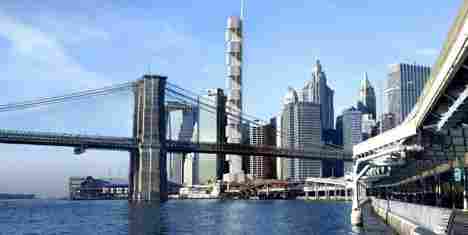
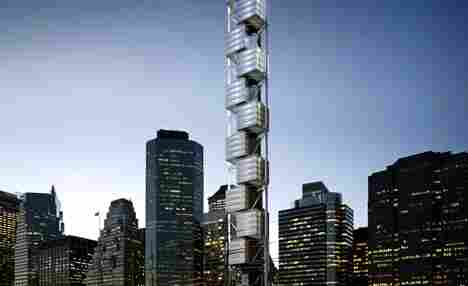
Solar-Powered 3D Printed Tower
Sand Babel is a group of ecological structures designed as scientific research facilities and tourist attractions for the desert. Divided into two parts above and below ground, the main portion of each is constructed with sand, sintered through a solar-powered 3D printer. The resulting top structure mimics the form of the desert’s natural phenomena like tornadoes and mushroom rocks!
The structure is divided into two parts: the first section is above ground and consists of several independent structures for a desert community while the second is partially underground connecting several buildings and creating a multi-functional tube network. The design utilizes a spiral skeleton structure which is tall and straight with tensile strength to meet the requirements of residential use, tourism and scientific research. The dual tunnel model not only improves cross-ventilation, but also generates water condensation atop the structures based on temperature differences. The net structure for the underground and surface sections is similar to the roots of a tree. The design not only helps to keep flowing sand dunes in place but also facilitates communication among the buildings.
Designers: Qiu Song, Kang Pengfei, Bai Ying, Ren Nuoya, & Guo Shen
